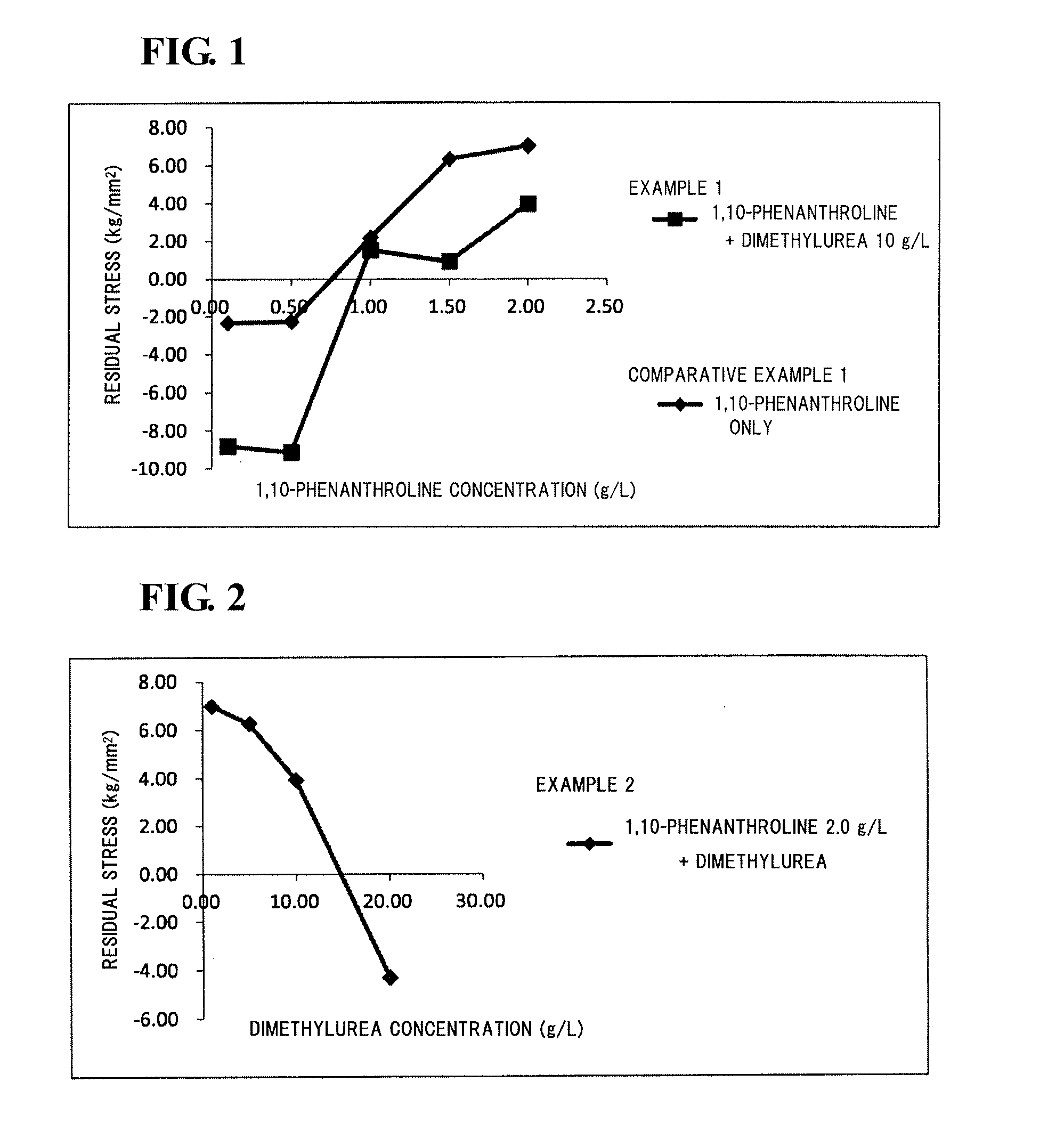Method for producing aluminum film
- Summary
- Abstract
- Description
- Claims
- Application Information
AI Technical Summary
Benefits of technology
Problems solved by technology
Method used
Image
Examples
example 1
[0061](Electrolyte Solution)
[0062]A molten salt was prepared by mixing 1-ethyl-3-methylimidazolium chloride (EMIC) and aluminum chloride (AlCl3) at a mixing ratio (by mole) of 1:2. Dimethylurea, as a compound B, was added at a concentration of 10 g / L to the molten salt.
[0063]Subsequently, electrolyte solutions were prepared by adding 1,10-phenanthroline at a concentration of 0.10, 0.50, 1.00, 1.50, or 2.00 g / L to the resulting molten salt.
[0064](Formation of Aluminum Film)
[0065]Using the individual electrolyte solutions prepared above, aluminum films were electrodeposited on surfaces of substrates.
[0066]Copper plates were used as the substrates. The substrates were each connected to the negative side of a rectifier, and an aluminum plate (purity 99.99%) as a counter electrode was connected to the positive side. The temperature of each of the electrolyte solutions was set to be 45° C., and the current density was controlled to be 2.5 A / dm2.
example 2
[0067](Electrolyte Solution)
[0068]A molten salt was prepared by mixing 1-ethyl-3-methylimidazolium chloride (EMIC) and aluminum chloride (AlCl3) at a mixing ratio (by mole) of 1:2. 1,10-Phenanthroline, as a compound A, was added at a concentration of 2.00 g / L to the molten salt.
[0069]Subsequently, electrolyte solutions were prepared by adding dimethylurea, as a compound B, at a concentration of 1.00, 5.00, 10.00, or 20.00 g / L to the resulting molten salt.
[0070](Formation of Aluminum Film)
[0071]Aluminum films were electrodeposited on surfaces of substrates (copper plates) as in Example 1 except that the individual electrolyte solutions prepared as described above were used.
example 3
[0073](Electrolyte Solution)
[0074]A molten salt was prepared by mixing 1-ethyl-3-methylimidazolium chloride (EMIC) and aluminum chloride (AlCl3) at a mixing ratio (by mole) of 1:2. Dimethylurea, as a compound B, was added at a concentration of 10 g / L to the molten salt.
[0075]Subsequently, electrolyte solutions were prepared by adding polystyrene with a number-average molecular weight of 40,000, as a compound A, at a concentration of 1.00, 1.50, 2.00, 2.50, or 5.00 g / L to the resulting molten salt.
[0076](Formation of Aluminum Film)
[0077]Aluminum films were electrodeposited on surfaces of substrates (copper plates) as in Example 1 except that the individual electrolyte solutions prepared as described above were used.
PUM
| Property | Measurement | Unit |
|---|---|---|
| Concentration | aaaaa | aaaaa |
| Concentration | aaaaa | aaaaa |
Abstract
Description
Claims
Application Information
 Login to View More
Login to View More - Generate Ideas
- Intellectual Property
- Life Sciences
- Materials
- Tech Scout
- Unparalleled Data Quality
- Higher Quality Content
- 60% Fewer Hallucinations
Browse by: Latest US Patents, China's latest patents, Technical Efficacy Thesaurus, Application Domain, Technology Topic, Popular Technical Reports.
© 2025 PatSnap. All rights reserved.Legal|Privacy policy|Modern Slavery Act Transparency Statement|Sitemap|About US| Contact US: help@patsnap.com



